Monday morning, as usual, I was stressed about planning the menu and making a shopping list. Maybe the problem was my messy recipe collection, in binders so thickly crammed that I couldn’t wrench them out of the cupboard without pulling everything else out with them. I decided it was time to tidy my recipes!
I’ve designated recipes as their own KonMari category, though technically they belong with papers. My reasoning is that my free time is in small chunks, so I need to break things down; and recipes are a distinct conceptual category for me, worthy of full concentration.
Let’s take a look at their current state. Leaving aside recipe books (which I tackled with other books), I have a card file and two binders of recipes, along with a notebook for jotting my own concoctions. Each of these three tools has, at times, formed the focus of a concerted effort to streamline my meal planning. Yet the whole collection still feels disorganised, and planning our meals and making the shopping list causes me so much stress each week. The actual shopping is far easier than the 15 minutes of planning.
Since starting the KonMari method, and seeing how directly my physical tools for a task affect how I perform the task, and how much I enjoy (or hate) it, I’m thinking that perhaps it’s my tools that make this task so hard.
So, out came all the recipes, and I went through each index card, printout, and magazine clipping.
This alerted me to problem 1 with my recipe collection: I treat it like an archive of all possible recipes to make, or recipes I have made, not like a selection of my favourites. I don’t keep the recipes I love; I keep everything. I keep recipes I made that we didn’t like. (I guess with the idea that I might tweak it and try again.) I keep recipes I’ve never made, and that don’t fit with our life, in case I might need a recipe of that type for some unlikely occasion.
I suspect that this keeping-everything method is the result of a lot of my mental fog surrounding recipes. It’s the same as any other category: I can’t find what I need in the sea of miscellaneous things, yet the feeling that ‘it’s there somewhere’ prevents me searching for a new recipe in a book or online. And, despite having tons of recipes, I often feel that ‘nothing to wear’ feeling: nothing to cook. Wouldn’t you know, I even managed to feel some guilt about my recipes – guilt over the healthy ones I never liked enough to make again, or the ones I painstakingly clipped out but never tried.
Problem number 2 with my collection was that my rationale for keeping everything was a shallow, formalised conception of myself: ‘I am a person who likes to cook.’ Now, I am a person who likes to cook. Just like I am a person who likes to read. But as with my books, this conception of myself somehow led to uncritical keeping of everything connected with that hobby. I was so fixated on ‘liking to cook’ that I never looked past it to ask, How do I like to cook? What do I enjoy cooking? What do I enjoy eating? What sort of physical form do I prefer my recipes to take? And since I do like to cook – and it’s something I spend a lot of time doing – that seems all the more reason that I should pursue these questions and spend time really honing my collection of recipes, instead of just keeping everything that comes my way without thought.
I applied the joy criteria and discarded around 50% of my recipes.
I also enjoyed a walk down memory lane. Mike laughs at me because anything can become fodder for a walk down memory lane for me. But I enjoy cooking and concocting, and certain recipes bring back all the sensations of a particular time and place. A gingerbread recipe, for example, that I made many times early in my PhD, reminds me of the kitchen I cooked in and the quest to find the British equivalent of molasses. I spied an elderly lady in the baking aisle as I was shopping and asked her to help me. I explained gingerbread; she translated ‘parkin’ (this was in the North). I asked for molasses, and she translated, ‘black treacle’. I can see the treacle tin in my cupboard and almost taste the gingerbread. I kept that recipe – maybe I’ll make it again this autumn.
After discarding, I needed to organise. I ran through various possible systems for this, scoping out online all the things I might purchase.
You know what? In the end I decided to forego shopping and keep an old-fashioned index card file, which was a gift from my grandmother. Also from my grandmother, I kept a three-ring binder which she customised with pictures of me baking with her when I was three years old. I had been eyeing all sorts of expensive organisation tools to cope with a vast and expanding selection of recipes, until I discarded half of mine and realised that this modest collection would fit happily into these two simple containers. Marie Kondo is right; if you have discarded first, when you come to organise you will most likely find that you already have the tools you need. I feel that my tendency to scope out new tools is often a symptom of not tidying up my things first – feeling that something is wrong, I seek to fix it by buying a new organisational device, instead of dealing with the things themselves.
What I did do was scrap the preprinted dividers, for both index cards and binder, and design my own based on the actual categories I use to cook. I’m sure there’s plenty of history to be discovered in the labels used to organise recipes. My grandmother’s proposed list, included with the binder, is apparently taken from Better Homes & Gardens (what year, I don’t know). ‘Candy’ receives a whole category to itself. Meanwhile, every type of meat is lumped together: not only red meat and poultry, but even fish. Casseroles are their own category, apparently conceptually distinct from ‘meat’. This does not at all reflect the way I – and I think many people today – actually cook and eat. I think it better reflects a mid-century ‘meat and two veg’ style of cooking.
Anyway, after reorganising, the final result is lovely and simple, and reflects the categories I use when looking for recipes.
My index card file represents my signature dishes: the ones we like most and which I can trust to turn out well, and which I regularly rotate to form our weekly menu. I can flip through them as I meal plan, and pin them to my bulletin board in the kitchen to serve as the menu.
The binder represents my archive, containing things that inspire me and I’d like to try, or things that I make more rarely, like holiday dishes. It contains the same categories as my card file, so things can move seamlessly between the systems. It also has a few extra categories, like ‘preserving’, and a category for menus from dinners I’ve hosted (like Thanksgiving), which are useful to have for similar future events.
Finally, I have a little notebook (which I titled ‘recipe lab notebook’) where I write working drafts of recipes I’m concocting, before committing them to the regular collection.
I was very happy to be able to locate the recipes for this week and put them up in the kitchen. The clarity I feel from this alone is wonderful. I no longer have to stand there – as I do many times throughout the day – trying to remember what’s for dinner and figure out when to start preparing it.
Next I’m tackling two small categories of household tools: our hardware and painting supplies, and stationery.
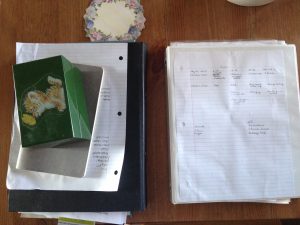
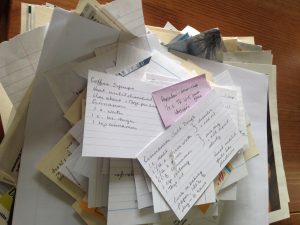
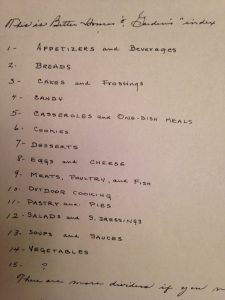
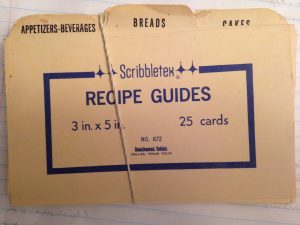
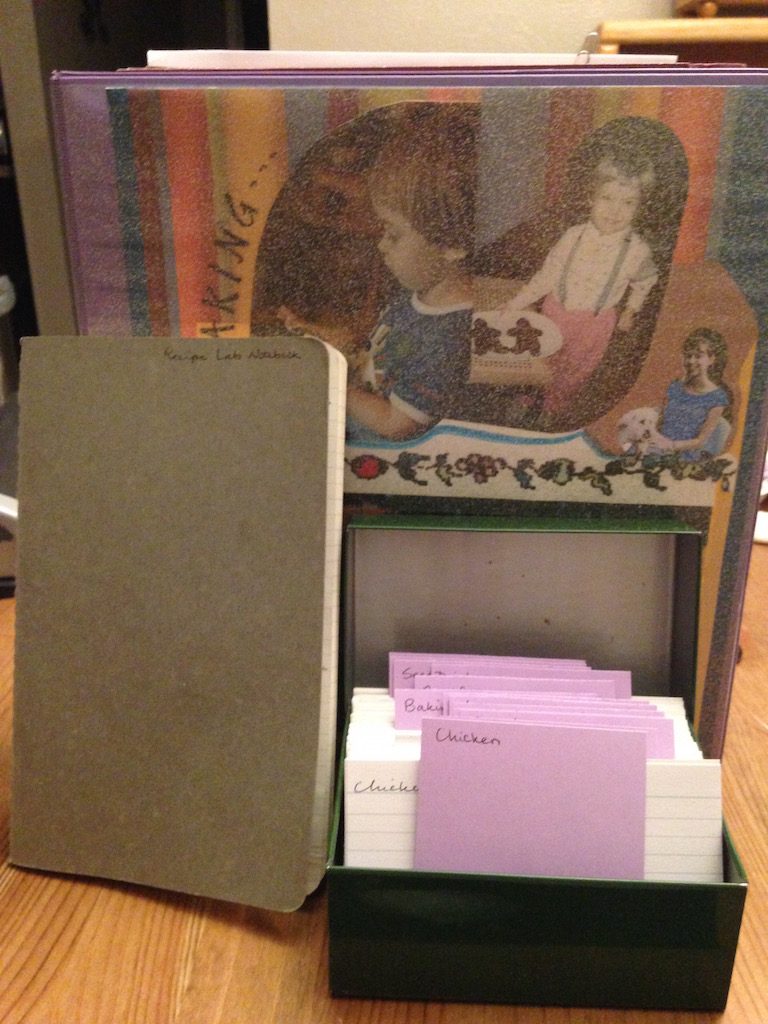
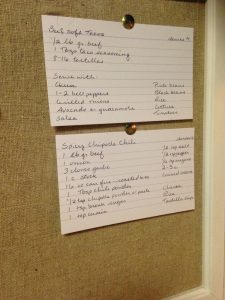
Wonderful simple sorting idea, you have inspired me to sort that area next after I finish clothes! Found your blog from a link on the simple year, and been enjoying having a read and being pushed to get things done around here – thanks!
Thanks for stopping by. Good luck getting things done – it feels really good, doesn’t it?